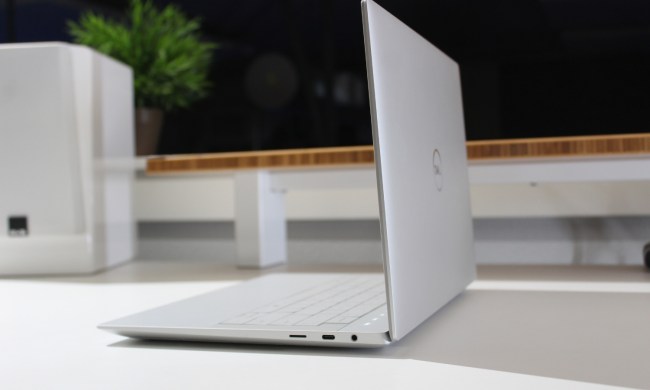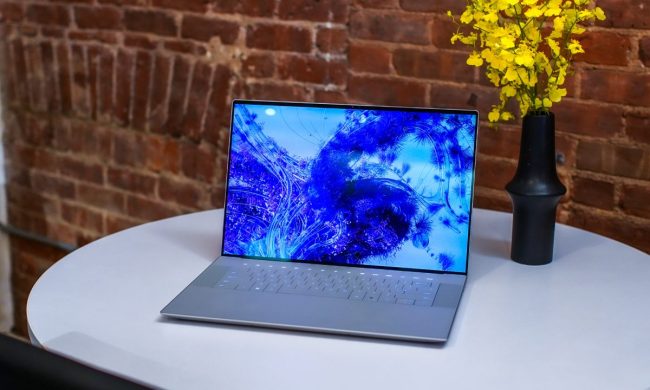- Excellent performance with Core i9
- Gorgeous, color-accurate OLED display
- Webcam placement has been fixed
- Convenient port selection
- Excellent keyboard and touchpad
- Familiar design
- Limited gaming performance
Editor’s Note: A redesigned version of the XPS 15 has launched, though the 2019 model is still being sold by Dell.
People need to work on the go, but laptops aren’t always well-equipped to handle it. The most powerful options are often too bulky, while portable options don’t have the brute force needed for some tasks. It’s a classic laptop compromise that buyers still face.
The Dell XPS 15, now in it its fourth generation, might finally make that compromise obsolete. The 2019 model can be optioned with the most advanced hardware you can imagine on a laptop. A 4K OLED screen, an eight-core Core i9 processor, and a Nvidia GTX 1650 discrete graphics chip. Is this the ultimate laptop for content creators?
Look closer
The XPS 15 is modest. Its aluminum lid and base appear common, and the soft interior plastic is a business-casual level of inoffensive. But excellence isn’t about the materials a company uses. It’s about how those materials form an enjoyable experience for the person using it. The XPS 15 makes a serious commitment to build quality and executes that commitment well.
Despite that, it doesn’t feel heavy or unwieldy. The XPS 15 definitely looks larger than it feels. At 4.2 pounds, it’s 0.2 pounds lighter than the MacBook Pro 15. You’ll feel the size and weight in your bag, but it’s still pretty trim compared to large gaming laptops or workstation PCs. I had no problem sliding it into the laptop pocket of my medium-sized backpack.
The display bezel is, as before, slim. The original XPS 15 launched with insanely thin bezels, and Dell has managed to keep those bezels without compromising the placement of the webcam. No longer a nose-cam, it’s squeezed into the tiny border above the screen.
The XPS 15 carries over its predecessor’s excellent keyboard and touchpad.
I can only complain about the stiff display hinge. It requires two hands to open and feels reluctant to unfold. It’s a shame the “variable torque” hinge from the 2019 XPS 13 didn’t make it over to the XPS 15.
Also missing from the XPS 15 are its little brother’s color options. A “rose gold” XPS 13 was introduced in 2018, and a “frost white” model came this year. Both offer a white, textured interior that I enjoyed as an alternative to the usual silver and black. More variety would be appreciated.

Unlike the MacBook Pro, the XPS 15 features a wide variety of ports. It includes a USB-A port, HDMI, USB-C (Thunderbolt 3), a barrel plug, and a headphone jack. On the right is on more USB-A port and, of course, an SD card slot. That’s a feature photographers and videographers will love, and sorely missed on modern MacBooks.
Fast, fluid, and familiar typing
The XPS 15 carries over its predecessor’s excellent keyboard and touchpad. The carbon-fiber texture interior is comfortable, and the palmrests doesn’t heat up, unlike the Razer Blade. Dell also beats Razer on keyboard layout. While the Blade makes odd decisions around the arrow keys, the XPS 15 is conventional. The key feel isn’t special, but easily beats a low-travel keyboard like on the MacBook Pro 15 or XPS 15 2-in-1. Typing is fast, fluid, and familiar.

The touchpad is also fantastic, offering a solid, slick mechanism and precise tracking. I wouldn’t mind it being larger, but there’s plenty of space, and Windows Precision enable numerous multi-touch gestures.
Windows Hello is supported through the fingerprint scanner, which is built into the power button. It’s reliable and conveniently located. I much prefer it over scanners built into the touchpad, which is common with competitors.
OLED? More like ‘Oh, wow’
This year’s XPS 15 upgrade focuses on OLED. While a 1080p LED screen remains standard, our review unit came with something special. An OLED 4K panel. This is the same AMOLED screen from Samsung that’d being used across many OLED laptops, though Dell has clearly tuned it for optimal color accuracy.
Dell’s 4K are always beautiful, but this OLED screen takes it to a new level. Though glossy, its brilliance means I rarely had to stare at my reflection. That’s a problem on other OLED laptops, like the Razer Blade.
As common with OLED, the screen has dazzling contrast. With infinitely deep black levels, everything from web browsing to HDR video looks incredible. That also makes a difference in content creation.
The display is a bit warmer than the MacBook Pro’s screen, but in the end, it’s a screen you can trust with your edits. That’s one of the most important considerations for a photographer or video editor on the go.

I do wish the speakers faced upwards instead of downwards. There’s room alongside the keyboard, and that would help improve the laptop’s mediocre audio. That’s one place the Razer Blade and MacBook Pro 15 can easily beat Dell’s XPS 15.
A laptop worthy of its eight cores
I’ve always known the Intel’s eight-core, Core i9 chip is an impressive mobile part, but I didn’t realize my previous experience with it wasn’t the chip’s full potential. Dell’s XPS 15 lets the Core i9 live its best life. Backed by 32GB of RAM and an excellent thermal profile, the processor blew past my expectations.
The leap isn’t as clear in synthetic benchmarks, though. In Geekbench 4, the XPS 15 was neck-and-neck with the MacBook Pro 15, which uses the same Core i9-9980HK processor. Its 4% lead in single-core performance, however, widens significantly in real-life tests.
The first performance test I tried was video encoding in Handbrake. I transcoded a 420MB 4K file to x265, and watched the XPS 15 complete the task 15% faster than the MacBook Pro. In fact, it set a record in the benchmark (aside from the Alienware Area-51M, which weighs 8.5 pounds and uses a desktop processor).
Still, I wasn’t satisfied. I wanted to know how the XPS 15 handles real video editing. As it turns out, that’s where the XPS 15 really shines. I pulled up a two-minute 4K video clip in Premiere Pro and, with the help of the Digital Trends video team, went to work.
The clip exported to ProRes 422 in an astounding 4 minutes and 55 seconds. That same export took 10 and a half minutes on the MacBook Pro, and 9 and a half on the Razer Blade. The MacBook would undoubtedly perform better in Final Cut, but considering how ubiquitous Premiere has become, I think this is a fair comparison. The XPS 15 is the video-editing king.
The Core i9 OLED model also came with a speedy storage solution: The Toshiba XG6. Its read speed was fast at an average of 1,450 MB/s. Its write speeds weren’t as fast as some competitors at 456 MB/s, but that’s not something I noticed in daily usage. The SSD and RAM can be swapped out or upgraded.
Gaming? Sure, I guess
The Dell XPS 15 is not a gaming laptop. It’s an important statement that might require some repeating. It has a decent discrete GPU in Nvidia’s GTX 1650, and it’s certainly an upgrade over last year’s GTX 1050 Ti. Yet it’s still not fast enough to satisfy demanding gamers.
Let’s start with 3DMark. The XPS 15 is a solid upgrade over the GTX 1050 Ti, represented in our comparison by the HP Spectre x360 15. However, it doesn’t come close to the Razer Blade. That laptop’s Nvidia RTX 2070 is a solid 37% faster in Time Spy, a lead that only grows in real gaming.
I tested the XPS 15 in four games: Fortnite, Civilization VI, Battlefield V, and Assassin’s Creed Odyssey. These games play well at Medium settings and 1080p. You won’t see 60 FPS in every game, but lighter fare like Fortnite cruises along even at Epic settings. Still, compared to a gaming laptop like the Razer Blade, it can’t keep up.
The XPS 15 performed best in Civilization VI, where it was 45% faster than the HP Spectre x360 15 and 32% slower than the Razer Blade. Posting 53 FPS at Ultra (in 1080p), Civilization VI felt smooth.
You shouldn’t expect to play at the screen’s native 4K resolution. OLED makes all games pop up a little more, but you’ll need a more powerful GPU to power games at 4K.
The Dell XPS 15’s thermal profile favors quiet operation and cool surface temperatures. The XPS 15 stays cool regardless of what it’s doing, even if that comes at the expense of performance.
Good battery life for a 4K laptop
Past XPS 15 models did well in our battery tests, especially the 1080p LED model. When I reviewed it last year, it lasted over 14 and a half hours in local video playback. The new 4K OLED model doesn’t last that long, but still posts respectable results.
The XPS 15 lasted around 7 and a half hours in light web browsing, and around an hour more in local video playback. That’s an hour worse than the HP Spectre x360 15, which also uses a 4K screen. It’s also a bit behind the MacBook Pro 15.
If you’re editing video or running any heavy application, you’re looking at closer to two hours, simulated by our Basemark benchmark.
All in all, it won’t last you a full workday away from the wall, but its posts strong results considering its high-resolution screen and fast Core i9 processor. Want maximum endurance? Look for the mid-range model that has a 1080p screen. The entry-level model might do well because of its less demanding hardware, but be warned; it also has a smaller battery.
Our take
The new Dell XPS 15 with Core i9 processor is the best video-editing laptop I’ve ever tested. It’s not even close. The combination of a beautiful OLED screen and eight cores of processing power make it a delight for content creators. Many laptops claim to focus on creators but fall short. Dell has delivered on its promise.
Is there a better alternative?
Only a few laptops have Intel’s mobile Core i9. Apple’s Macbook Pro 16 is the most popular. Recently introduced, the MacBook Pro 16 has a slightly larger display and a great keyboard. We’ll have to test it further to decide if it can beat the Dell, though.
Another option is the ZenBook Pro Duo, a unique two-screen laptop that also includes the powerful Core i9 chip. We haven’t tested it yet, but at nearly an inch thick and almost five pounds, it’s less portable than the XPS 15.
The Razer Blade is obviously better for gamers. It doesn’t offer the Core i9, however, which puts it behind the fastest competitors in processor performance.
How long will it last?
The XPS 15 is a durable, future-proofed laptop. It’s insanely powerful with its updated components, and the RAM and SSD can even be swapped out. This laptop is likely to last five years or more.
Should you buy it?
Yes. If you’re looking for a 15-inch laptop, you won’t find a better option than the XPS 15. The more affordable configurations offer a balance of value and performance. If you’re a content creator, though, this OLED Core i9 model is the supercharged machine you’ve been waiting for.




